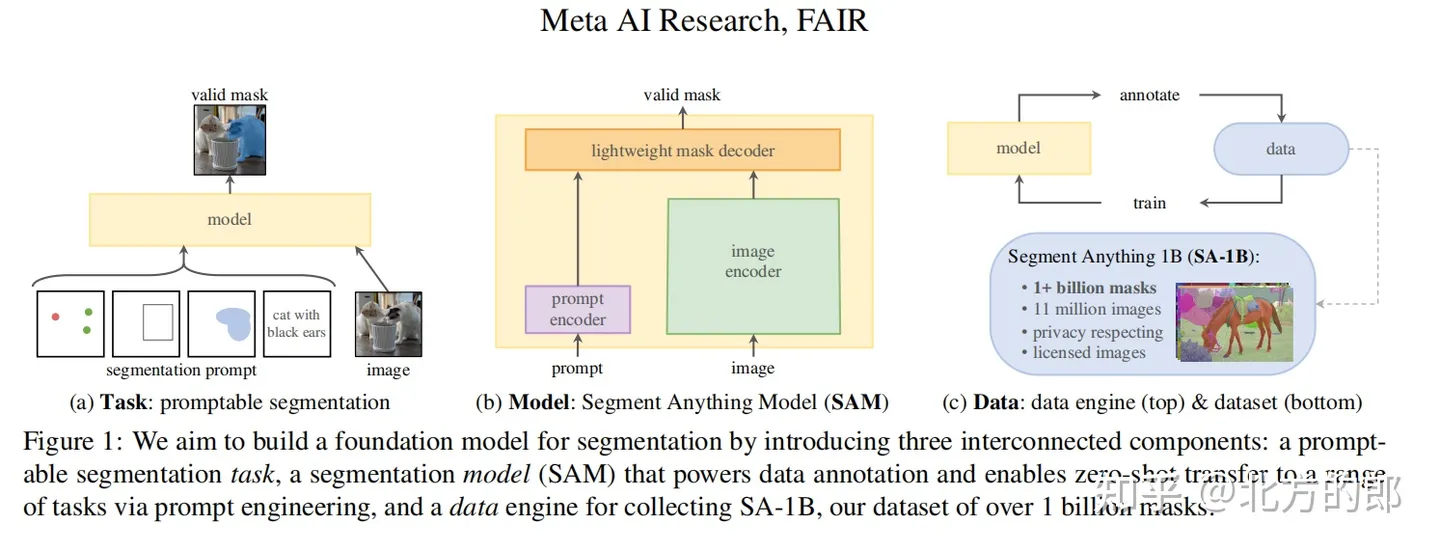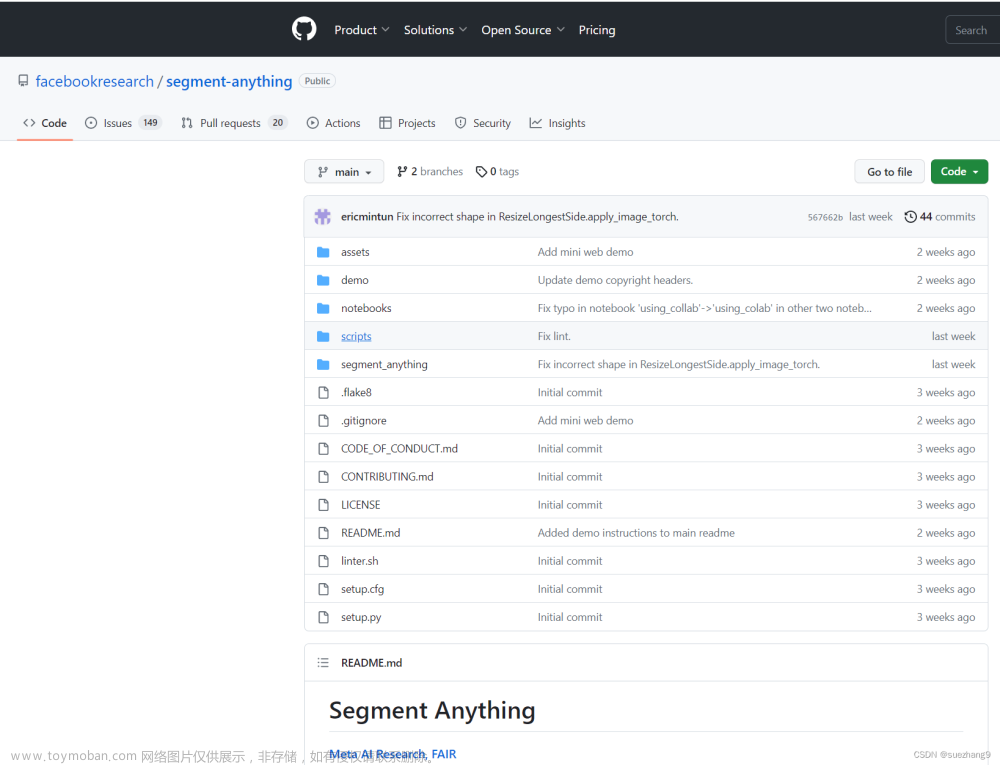


近日,Meta AI在官网发布了基础模型 Segment Anything Model(SAM)并开源,其本质是用GPT的方式(基于Transform 模型架构)让计算机具备理解了图像里面的一个个“对象”的通用能力。SAM模型建立了一个可以接受文本提示、基于海量数据(603138)训练而获得泛化能力的图像分割大模型。图像分割是计算机视觉中的一项重要任务,有助于识别和确认图像中的不同物体,把它们从背景中分离出来,这在自动驾驶(检测其他汽车、行人和障碍物)、医学成像(提取特定结构或潜在病灶)等应用中特别重要。文章来源:https://www.toymoban.com/news/detail-752540.html
下面是 java 使用 onnx 进行推理的分割代码,提示抠图点进行分割,目前还没有文本交互式提示的部署按理。代码如下:文章来源地址https://www.toymoban.com/news/detail-752540.html
package tool.deeplearning;
import ai.onnxruntime.*;
import org.opencv.core.*;
import org.opencv.imgcodecs.Imgcodecs;
import org.opencv.imgproc.Imgproc;
import javax.imageio.ImageIO;
import javax.swing.*;
import java.awt.*;
import java.awt.image.BufferedImage;
import java.io.ByteArrayInputStream;
import java.io.File;
import java.nio.FloatBuffer;
import java.util.*;
/**
* @desc : meta-ai sam , 使用抠图点进行分割
* @auth : tyf
* @date : 2023-04-25 09:34:40
*/
public class metaai_sam_test {
// 模型1
public static OrtEnvironment env1;
public static OrtSession session1;
// 模型2
public static OrtEnvironment env2;
public static OrtSession session2;
// 模型1
public static void init1(String weight) throws Exception{
// opencv 库
System.loadLibrary(Core.NATIVE_LIBRARY_NAME);
env1 = OrtEnvironment.getEnvironment();
session1 = env1.createSession(weight, new OrtSession.SessionOptions());
// 打印模型信息,获取输入输出的shape以及类型:
System.out.println("---------模型1输入-----------");
session1.getInputInfo().entrySet().stream().forEach(n->{
String inputName = n.getKey();
NodeInfo inputInfo = n.getValue();
long[] shape = ((TensorInfo)inputInfo.getInfo()).getShape();
String javaType = ((TensorInfo)inputInfo.getInfo()).type.toString();
System.out.println(inputName+" -> "+ Arrays.toString(shape)+" -> "+javaType);
});
System.out.println("---------模型1输出-----------");
session1.getOutputInfo().entrySet().stream().forEach(n->{
String outputName = n.getKey();
NodeInfo outputInfo = n.getValue();
long[] shape = ((TensorInfo)outputInfo.getInfo()).getShape();
String javaType = ((TensorInfo)outputInfo.getInfo()).type.toString();
System.out.println(outputName+" -> "+Arrays.toString(shape)+" -> "+javaType);
});
// session1.getMetadata().getCustomMetadata().entrySet().forEach(n->{
// System.out.println("元数据:"+n.getKey()+","+n.getValue());
// });
}
// 模型2
public static void init2(String weight) throws Exception{
// opencv 库
System.loadLibrary(Core.NATIVE_LIBRARY_NAME);
env2 = OrtEnvironment.getEnvironment();
session2 = env2.createSession(weight, new OrtSession.SessionOptions());
// 打印模型信息,获取输入输出的shape以及类型:
System.out.println("---------模型2输入-----------");
session2.getInputInfo().entrySet().stream().forEach(n->{
String inputName = n.getKey();
NodeInfo inputInfo = n.getValue();
long[] shape = ((TensorInfo)inputInfo.getInfo()).getShape();
String javaType = ((TensorInfo)inputInfo.getInfo()).type.toString();
System.out.println(inputName+" -> "+ Arrays.toString(shape)+" -> "+javaType);
});
System.out.println("---------模型2输出-----------");
session2.getOutputInfo().entrySet().stream().forEach(n->{
String outputName = n.getKey();
NodeInfo outputInfo = n.getValue();
long[] shape = ((TensorInfo)outputInfo.getInfo()).getShape();
String javaType = ((TensorInfo)outputInfo.getInfo()).type.toString();
System.out.println(outputName+" -> "+Arrays.toString(shape)+" -> "+javaType);
});
// session2.getMetadata().getCustomMetadata().entrySet().forEach(n->{
// System.out.println("元数据:"+n.getKey()+","+n.getValue());
// });
}
public static class ImageObj{
// 原始图片
Mat src;
Mat dst_3_1024_1024;
BufferedImage image_3_1024_1024;
float[][][] image_embeddings;
ArrayList<float[]> points;
float[][] info;
public ImageObj(String image) {
this.src = this.readImg(image);
this.dst_3_1024_1024 = this.resizeWithoutPadding(src,1024,1024);
this.image_3_1024_1024 = mat2BufferedImage(this.dst_3_1024_1024);
}
public void setPoints(ArrayList<float[]> points) {
this.points = points;
}
public Mat readImg(String path){
Mat img = Imgcodecs.imread(path);
return img;
}
public Mat resizeWithoutPadding(Mat src,int inputWidth,int inputHeight){
Mat resizedImage = new Mat();
Size size = new Size(inputWidth, inputHeight);
Imgproc.resize(src, resizedImage, size, 0, 0, Imgproc.INTER_AREA);
return resizedImage;
}
public float[] chw2chw(float[][][] chw,int c,int h,int w){
float[] res = new float[ c * h * w ];
int index = 0;
for(int i=0;i<c;i++){
for(int j=0;j<h;j++){
for(int k=0;k<w;k++){
float d = chw[i][j][k];
res[index] = d;
index++;
}
}
}
return res;
}
// 推理1
public void infenence1() throws Exception{
Imgproc.cvtColor(dst_3_1024_1024, dst_3_1024_1024, Imgproc.COLOR_BGR2RGB);
dst_3_1024_1024.convertTo(dst_3_1024_1024, CvType.CV_32FC1);
float[] whc = new float[ 3 * 1024 * 1024];
dst_3_1024_1024.get(0, 0, whc);
float[] chw = new float[whc.length];
int j = 0;
for (int ch = 0; ch < 3; ++ch) {
for (int i = ch; i < whc.length; i += 3) {
chw[j] = whc[i];
j++;
}
}
float mean = 0.0f;
float std = 0.0f;
for (int i = 0; i < chw.length; i++) {
mean += chw[i];
}
mean /= chw.length;
for (int i = 0; i < chw.length; i++) {
std += Math.pow(chw[i] - mean, 2);
}
std = (float) Math.sqrt(std / chw.length);
for (int i = 0; i < chw.length; i++) {
chw[i] = (chw[i] - mean) / std;
}
OnnxTensor tensor = OnnxTensor.createTensor(env1, FloatBuffer.wrap(chw), new long[]{1,3,1024,1024});
OrtSession.Result res = session1.run(Collections.singletonMap("x", tensor));
float[][][] image_embeddings = ((float[][][][])(res.get(0)).getValue())[0];
this.image_embeddings = image_embeddings;
}
// 推理2
public void infenence2() throws Exception{
float[] chw = this.chw2chw(this.image_embeddings,256,64,64);
OnnxTensor _image_embeddings = OnnxTensor.createTensor(env2, FloatBuffer.wrap(chw), new long[]{1,256, 64, 64});
float[] pc = new float[points.size()*2];
float[] pc_label = new float[points.size()];
for(int i=0;i<points.size();i++){
float[] xyl = points.get(i);
pc[i*2] = xyl[0] * 1024f / Float.valueOf(src.width());
pc[i*2+1] = xyl[1] * 1024f / Float.valueOf(src.height());
pc_label[i] = xyl[2];
}
OnnxTensor _point_coords = OnnxTensor.createTensor(env2, FloatBuffer.wrap(pc), new long[]{1,points.size(),2});
OnnxTensor _point_labels = OnnxTensor.createTensor(env2, FloatBuffer.wrap(pc_label), new long[]{1,points.size()});
OnnxTensor _orig_im_size = OnnxTensor.createTensor(env2, FloatBuffer.wrap(new float[]{1024,1024}), new long[]{2});
OnnxTensor _has_mask_input = OnnxTensor.createTensor(env2, FloatBuffer.wrap(new float[]{0}), new long[]{1});
float[] ar_256_156 = new float[256*256];
for(int i=0;i<256*156;i++){
ar_256_156[i] = 0;
}
OnnxTensor _mask_input = OnnxTensor.createTensor(env2, FloatBuffer.wrap(ar_256_156), new long[]{1,1,256,256});
// 封装参数
Map<String,OnnxTensor> in = new HashMap<>();
in.put("image_embeddings",_image_embeddings);
in.put("point_coords", _point_coords);
in.put("point_labels",_point_labels);
in.put("has_mask_input",_has_mask_input);
in.put("orig_im_size",_orig_im_size);
in.put("mask_input",_mask_input);
// 推理
OrtSession.Result res = session2.run(in);
float[][][] masks = ((float[][][][])(res.get(0)).getValue())[0];
float[][] iou_predictions = ((float[][])(res.get(1)).getValue());
float[][][][] low_res_masks = ((float[][][][])(res.get(2)).getValue());
int count = masks.length;
for(int i=0;i < count;i++){
float[][] info = masks[i];
this.info = info;
break;
}
}
public BufferedImage mat2BufferedImage(Mat mat){
BufferedImage bufferedImage = null;
try {
MatOfByte matOfByte = new MatOfByte();
Imgcodecs.imencode(".jpg", mat, matOfByte);
byte[] byteArray = matOfByte.toArray();
ByteArrayInputStream byteArrayInputStream = new ByteArrayInputStream(byteArray);
bufferedImage = ImageIO.read(byteArrayInputStream);
} catch (Exception e) {
e.printStackTrace();
}
return bufferedImage;
}
public BufferedImage resize(BufferedImage img, int newWidth, int newHeight) {
Image scaledImage = img.getScaledInstance(newWidth, newHeight, Image.SCALE_SMOOTH);
BufferedImage scaledBufferedImage = new BufferedImage(newWidth, newHeight, BufferedImage.TYPE_INT_ARGB);
Graphics2D g2d = scaledBufferedImage.createGraphics();
g2d.drawImage(scaledImage, 0, 0, null);
g2d.dispose();
return scaledBufferedImage;
}
public void show(){
int sub_w = info.length;
int sub_h = info[0].length;
for(int j=0;j<sub_w;j++){
for(int k=0;k<sub_h;k++){
float da = info[j][k];
da = da + 1;
if(da>0.5){
// 修改颜色为绿色
image_3_1024_1024.setRGB(k,j, Color.GREEN.getRGB());
}
}
}
BufferedImage showImg = resize(image_3_1024_1024,src.width(),src.height());
// 弹窗显示
JFrame frame = new JFrame();
frame.setTitle("Meta-ai: SAM");
JPanel content = new JPanel();
content.add(new JLabel(new ImageIcon(showImg)));
frame.add(content);
frame.pack();
frame.setVisible(true);
}
}
public static void main(String[] args) throws Exception{
init1(new File("").getCanonicalPath()+
"\\src\\main\\resources\\deeplearning\\metaai_sam\\encoder-vit_b.quant.onnx");
init2(new File("").getCanonicalPath()+
"\\src\\main\\resources\\deeplearning\\metaai_sam\\decoder-vit_b.quant.onnx");
// 图片
ImageObj imageObj = new ImageObj(new File("").getCanonicalPath()+
"\\src\\main\\resources\\deeplearning\\metaai_sam\\truck.jpg");
// 提示,这里使用抠图点进行提示,可以设置多个提示点
ArrayList<float[]> points = new ArrayList<>();
points.add(new float[]{514,357,1});// 车窗户
points.add(new float[]{555,377,1});// 车窗户
points.add(new float[]{556,387,1});// 车窗户
imageObj.setPoints(points);
// 推理
imageObj.infenence1();
imageObj.infenence2();
// 显示
imageObj.show();
}
}
到了这里,关于使用 java-onnx 部署 Meta-ai Segment anything 分割一切的文章就介绍完了。如果您还想了解更多内容,请在右上角搜索TOY模板网以前的文章或继续浏览下面的相关文章,希望大家以后多多支持TOY模板网!














